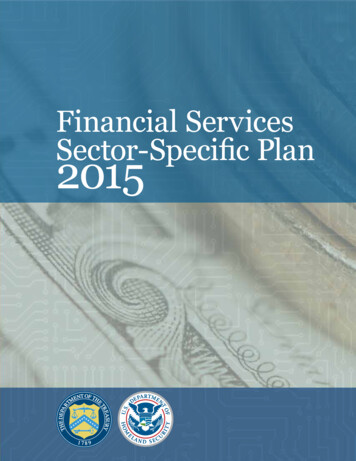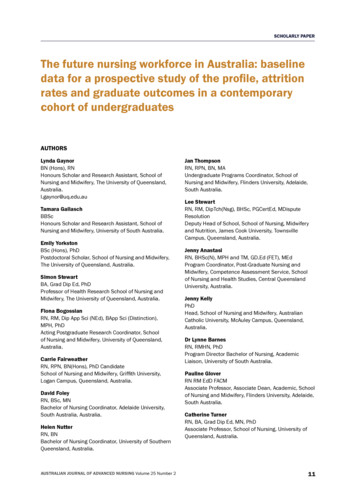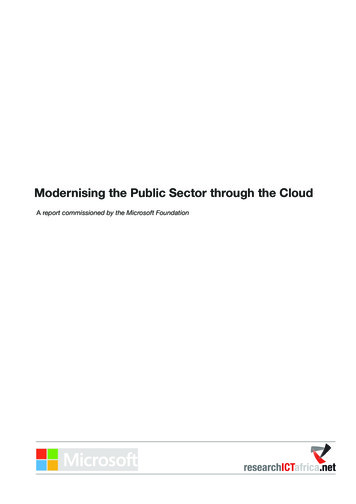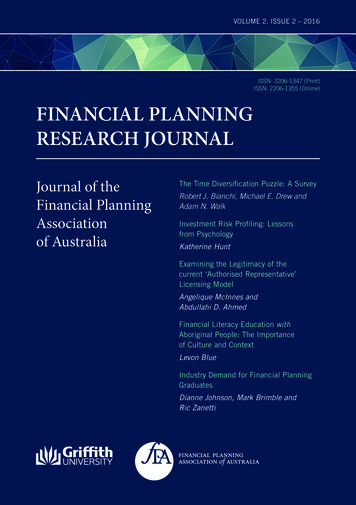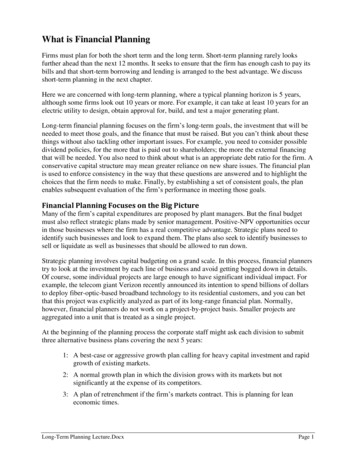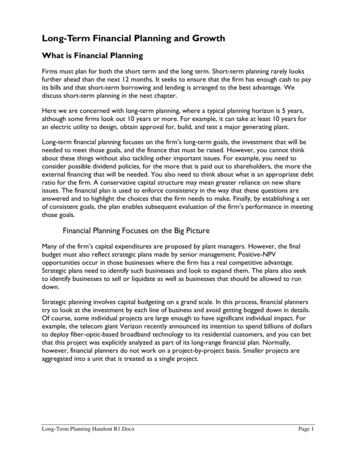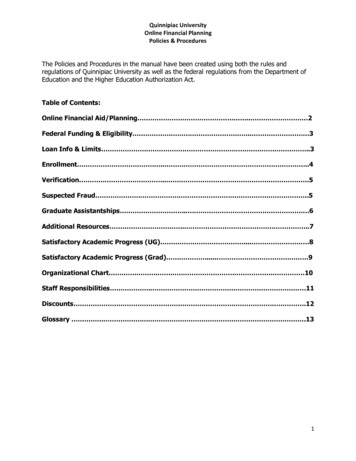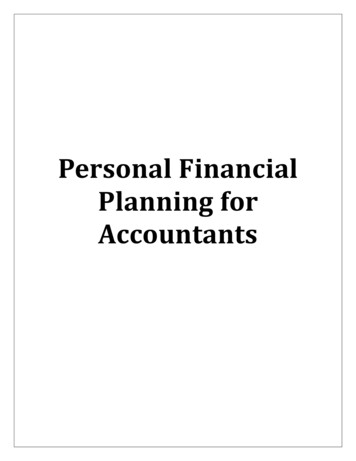
Transcription
AUSTRALIA’SFINANCIAL PLANNINGSECTOR MONEY LAUNDERING AND TERRORISM FINANCINGRISK ASSESSMENT
02RISK ASSESSMENT: FINANCIAL PLANNING SECTORAUSTRALIA'SFINANCIAL PLANNING SECTOR 4.61,574IN REVENUE*FINANCIALPLANNINGBUSINESSES*20%25,000 BILLIONOF ADULT AUSTRALIANSSEEK FINANCIALA D V I C E**FINANCIALPLANNERS ***SUSPICIOUS MATTER REPORTS (SMRs)RELATING TO FINANCIAL PLANNINGFROM 1 APRIL 2014 TO 31 MARCH 2016***273675SMRsSUBMITTEDREPORTING ENTITIES (REs)SUBMITED AT LEAST 1 SMRREs SUBMITED HALFOF THE SMRsIBISWorld, IBISWorld Industry Report K6419b: Financial Planning and Investment Advice in Australia, 2016Based on the ANZ Survey of Adult Financial Literacy in Australia (May 2015), 20 per cent of adult Australians used a financial planner or advisor for financial advicein the last 12 months (2014 ANZ survey) eport.pdf*** Australians Securities & Investments Commission Financial Adviser Register, December 2016.
RISK ASSESSMENT: FINANCIAL PLANNING SECTOR03CONTENTSEXECUTIVE SUMMARY. 4PURPOSE. 6METHODOLOGY. 7REPORTING TO AUSTRAC. 8CRIMINAL THREAT ENVIRONMENT . 10Money laundering . 12Terrorism financing. 13Cyber-enabled fraud. 14Other fraud. 15Tax evasion. 16Welfare fraud. 16VULNERABILITIES. 17Customers. 17Source of funds and wealth. 19Products and services. 19Delivery channel. 21Foreign jurisdiction. 22Use of cash. 23Operational vulnerabilities. 23AML/CTF systems and controls. 24CONSEQUENCES. 25CONCLUSION. 26APPENDIX A: Risk assessment methodology. 27This risk assessment is intended to provide a summary and general overview; it does not assess every risk orproduct relevant to the financial planning sector. It does not set out the comprehensive obligations under theAnti-Money Laundering and Counter-Terrorism Financing (AML/CTF) Act 2006, AML/CTF Regulations and AML/CTFRules. It does not constitute nor should it be treated as legal advice or opinions. The Commonwealth accepts noliability for any loss suffered as a result of reliance on this publication. AUSTRAC recommends that independentprofessional advice be sought.
04RISK ASSESSMENT: FINANCIAL PLANNING SECTOREXECUTIVE SUMMARYOVERALL RISK RATINGLOWMEDIUMHIGHAUSTRAC assesses the overall money laundering and terrorism financing (ML/TF) risk for the financial planningsector as medium. This rating is based on assessments of the criminal threat environment, the vulnerabilities inthe sector, and the consequences associated with the criminal threat.CRIMINAL THREAT ENVIRONMENTLOWMEDIUMHIGHAUSTRAC has assessed that Australia’s financialplanning sector faces a variety of threats, some ofwhich involve sophisticated tactics and methods.Intelligence agencies have observed instances oforganised crime groups using financial planners tohelp navigate the financial sector.The most frequently reported offence in the sectorwas cyber-enabled fraud, which accounted forhalf of all SMRs. This threat has been growing inscale and sophistication, with financial plannersbeing targeted as they act as a gateway betweencustomers and financial institutions.Of the suspicious matters reports (SMRs) submittedto AUSTRAC related to the financial planning sectorover a two-year period, around one-fifth relatedto suspected money laundering, often involvinghigh-value transactions. Few incidents of terrorismfinancing have been reported in the sector;however, financial planners should remain vigilant tothis threat.Other fraud-related offences included scams, theuse of false documents, as well as suspected casesof fraud conducted by financial planners. There werealso a small number of SMRs regarding customer taxevasion and welfare fraud.The true extent of criminal activity in the financialplanning sector is likely to be greater than reportinglevels indicate, as AUSTRAC assesses that there issignificant under-reporting of suspicious mattersby financial planners. Over two years, AUSTRACreceived 273 SMRs related to the financial planningsector, which is very low considering around 20 percent of adult Australians seek financial advice fromsome 25,000 financial planners across the country.
RISK ASSESSMENT: FINANCIAL PLANNING SECTOR05VULNERABILITIESLOWMEDIUMHIGHFinancial planners play an important facilitationrole for their customers to access financial services.This can make financial planners susceptible toexploitation for criminal purposes.are politically exposed persons (PEPs), or makepayments to third-party accounts may be exposedto higher levels of risk than those that do notundertake these activities.The specific characteristics of the financial planningsector that make it vulnerable to financial crimesinclude:Factors that limit the overall vulnerability of thesector include the low level of customer anonymityfor personal advice services and the low level ofagents acting for customers. the large customer base and significant amountof money movement being facilitated byfinancial planners the range and complexity of products andinvestment strategies being facilitated byfinancial planners the growing trend towards online delivery offinancial planning services.Financial planners who deal with foreignjurisdictions, accept cash, have customers whoAUSTRAC assesses that, at a sector level, financialplanners have only a partial understanding of theiranti-money laundering and counter-terrorismfinancing (AML/CTF) obligations, with many notfulfilling the requirements to have risk-basedcustomer due diligence procedures and to submitSMRs to AUSTRAC. Almost all entities engaged forthis assessment saw this lack of understanding asa significant vulnerability which undermines thesector’s resilience to criminal financial activity.CONSEQUENCESMINORMODERATEThe consequences of ML/TF activity in the sectorare assessed as minor overall; however, there canbe quite significant personal consequences forcustomers who incur financial losses due to criminalactivity.Consequences for financial planners could includecrime-related financial losses, reputational damage,and increased costs associated with combatingcriminal activity, particularly IT security costs.MAJORThere may also be loss of confidence in the financialplanning sector as a whole by both customers andproduct issuers.Financial crimes in this sector may also impact thebroader Australian economy; for example, throughloss of investments as a result of fraud and reducedgovernment revenue from unreported welfare fraudand tax evasion.
06RISK ASSESSMENT: FINANCIAL PLANNING SECTORPURPOSEThis assessment provides sector-specific informationto the financial planning industry on ML/TF risksat the national level. Its primary aim is to assist thesector to combat ML/TF crimes in Australia’s financialsystem.Financial planners have obligations under theAnti-Money Laundering and Counter-TerrorismFinancing Act 2006 (AML/CTF Act) when they makearrangements for a person to receive a financialproduct or service in their capacity as a holder ofan Australian Financial Services Licence (AFSL).1This is listed as designated service item 54 in Table 1,subsection 6(2) of the AML/CTF Act.2This risk assessment has been developed as afeedback resource for the financial planning sector.AUSTRAC expects that reporting entities will use thisassessment to refine their own compliance controlsand mitigation strategies. This risk assessment alsoaims to help financial planners identify and monitorrisks that may be applicable to their individualbusinesses, and to subsequently report suspiciousmatters to AUSTRAC. Reporting entities shouldapply information in this assessment in a way thatis consistent with the nature, size and complexityof their businesses, and the ML/TF risk posed bytheir designated services and customers. FutureAUSTRAC compliance activities will assess howreporting entities in the sector have responded tothe information provided here.AML/CTF obligations for financialplannersReporting entities that only provide designatedservice item 54 have reduced obligations underthe AML/CTF Act. They are required to adoptand implement a ‘special AML/CTF program’ inaccordance with Chapter 5 of the AML/CTFRules.3 Reporting entities that provide anotherdesignated service in addition to the item 54service are required to implement a standardAML/CTF program.Under a special AML/CTF program, financialplanners are required to implement customerdue diligence (CDD) procedures 4, including:- collecting and verifying customer identificationinformation- identifying and verifying beneficial ownership- identifying whether a customer is a PEP- obtaining information on the purpose andintended nature of the business relationship.When implementing the special AML/CTF program,reporting entities are also required to consider theML/TF risks posed by various factors, including (butnot limited to):- customer types- customers’ sources of funds and wealth- delivery channel- any foreign jurisdictions the reporting entitydeals with.3 For further information, see the AUSTRAC Compliance Guide,Chapter 6 – AML/CTF f-programs1 Or as an authorised representative of an AFSL holder2 For further information on designated service item 54, les-commondesignated-services4 For the purpose of this risk assessment, the term ‘customerdue diligence’ is used in reference to the requirements asoutlined in Chapter 4 of the AML/CTF Rules to conduct‘applicable customer identification procedures’ (ACIP). Ongoingcustomer due diligence requirements (OCDD) do not apply toproviders of designated service item 54, in accordance withsubsection 36(3) of the AML/CTF Act.
RISK ASSESSMENT: FINANCIAL PLANNING SECTOR07METHODOLOGYThe methodology used for this risk assessmentfollows Financial Action Task Force (FATF) guidancethat states that ML/TF risk at the national levelshould be assessed as a function of: criminal threat,vulnerability and consequence. According to thismethodology: Criminal threat environment refers to theextent and nature of ML/TF and other offencesin a sector. Vulnerability refers to the characteristicsof a sector that make it attractive for ML/TFpurposes. This includes features of a particularsector that can be exploited, such as customertypes, products and services, designated servicedelivery channels and the foreign jurisdictionswith which the sector deals. Vulnerability isalso influenced by the AML/CTF systems andcontrols in place across the sector. Consequence refers to the impact or harm thatML/TF activity may cause.This assessment considered 26 risk factors acrossthese three categories. An average risk rating isdetermined for each category, which is then usedto determine an overall risk rating for the sector.Further information on the methodology and howthis was applied to the financial planning sector is atAppendix A.Three main intelligence inputs informed the riskratings within this assessment: analysis of SMRs, as well as other AUSTRACinformation and intelligence reports and intelligence from a variety of partneragencies, including intelligence, revenue, lawenforcement and regulatory agencies acrossgovernment feedback and professional insights offeredduring interviews and consultations with arange of financial planning entities, as well asindustry experts and industry associations.
08RISK ASSESSMENT: FINANCIAL PLANNING SECTORREPORTING TO AUSTRACUnder the AML/CTF Act, financial planners, asreporting entities, have an obligation to reportsuspicious matters to AUSTRAC. 5 A reporting entitymust submit an SMR if they form a reasonablesuspicion of money laundering, terrorism financingor other offences such as fraud or tax evasion.26 per cent of the SMRs in the sample datasetrelated to cases in which a financial planner wassuspected of being involved in an offence. Thesewere generally reported by banks and productissuers, and may reflect more advanced reportingpractices by these institutions.SMRs submitted by the financial planning sectorprovide valuable intelligence to AUSTRAC. Workingwith its partner agencies, AUSTRAC pieces togetherintelligence from a range of sources to developa picture of criminal activities and networks.Many of AUSTRAC’s partner agencies – includingthe Australian Federal Police, Australian CriminalIntelligence Commission and the Australian TaxationOffice – have access to AUSTRAC SMRs in order toconduct further analysis and investigation.The remaining 55 per cent of SMRs related tooffences in which a third party was the suspiciousparty. This includes parties that were unknown tothe customer or financial planner (for example,cyber-criminals), or entities with a connection to acustomer (for example, investment scammers).For this risk assessment, AUSTRAC analysed in detailall SMRs lodged over a two-year period, where: the SMR had been lodged by a financial planner; or the SMR had been submitted by anotherfinancial institution, but a financial planner hadidentified the suspicious matter or had beeninvolved in the transaction in some way.AUSTRAC observed that a large range of values werereported in the SMRs during the sample period. Ofthe 152 SMRs that reported a dollar-figure value, 44per cent had a value of less than 50,000, and 24 percent reported amounts greater than 250,000; nineof these were worth over 1 million.AUSTRAC also analysed the SMRs to determine whothe suspicious party was in each case. In 19 per centof SMRs, the suspicious party was the customer ofa financial planner. That equates to only one SMRbeing submitted per fortnight by financial plannersnationwide in relation to their customers. This is alow rate of reporting, considering around 20 percent of adult Australians seek financial advice. 6Most entities consulted for this assessment agreedthat this figure was surprisingly low.5 For more information on when to submit an SMR, seesection 41 of the AML/CTF Act and Chapter 7 of the AUSTRACCompliance Guide6 Based on the ANZ Survey of Adult Financial Literacy in Australia(May 2015), eport.pdfSMRS RELATING TO FINANCIALPLANNING273675 75.9MNumber of SMRssubmittedNumber of reporting entitiessubmitting at least one SMRNumber of reporting entities accountingfor half of all SMRs submittedTotal value of transactionsreported in SMRs** 120 SMRs did not specify a value1 April 2014 to 31 March 2016
RISK ASSESSMENT: FINANCIAL PLANNING SECTOR09Common misconceptions aboutsuspicious matter reportingAUSTRAC’s engagement with the financial planningsector for this assessment revealed several industrymisconceptions about SMR reporting. Thesemisconceptions are likely to contribute to the lowlevel of reporting by financial planners.1. “The product issuer will report instead.”Some financial planners seemed to consider it thefinancial institution or product issuer’s obligationto report SMRs. However, financial planners are alsorequired to report SMRs to AUSTRAC, and may haveinformation about a customer that the financialinstitution does not.2. “I need to have conclusive evidence.” An SMRmust be submitted when a reporting entity formsa suspicion on reasonable grounds, regardlessof whether there is conclusive evidence that anyillegal activity has occurred. Information providedby financial planners in an SMR could assist withinvestigations by authorities.Furthermore, there are provisions in the AML/CTFAct which enable reporting entities to report onsuspicious matters without compromising theconfidentiality of the customer or the reportingentity. ‘Tipping off’ provisions prohibit reportingentities from disclosing information relating toan SMR to the customer or to other financialinstitutions. Should a court case be brought againsta customer, the information in the SMR cannot beintroduced as evidence in criminal proceedings,7which provides further protection of confidentiality.4. “Reporting means my business has donesomething wrong.” Reporting suspicious mattersto AUSTRAC demonstrates that the financial planneris acting in accordance with its AML/CTF obligations.In contrast, financial planners who do not submitSMRs, despite forming a suspicion on reasonablegrounds, may become implicated and potentiallyput Australia’s financial system and national securit
this was applied to the financial planning sector is at Appendix A. Three main intelligence inputs informed the risk ratings within this assessment: analysis of SMRs, as well as other AUSTRAC information and intelligence reports and intelligence from a variety of partner agencies, including intelligence, revenue, law

